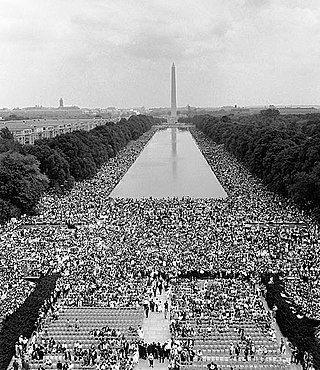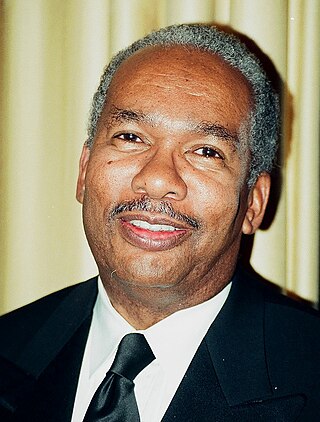Related Research Articles

Martin Luther King Jr. was an American Baptist minister, activist, and political philosopher who was one of the most prominent leaders in the civil rights movement from 1955 until his assassination in 1968. A Black church leader and a son of early civil rights activist and minister Martin Luther King Sr., King advanced civil rights for people of color in the United States through nonviolence and civil disobedience. Inspired by his Christian beliefs and the nonviolent activism of Mahatma Gandhi, he led targeted, nonviolent resistance against Jim Crow laws and other forms of discrimination in the United States.

The civil rights movement was a nonviolent social movement and campaign from 1954 to 1968 in the United States to abolish legalized racial segregation, discrimination, and disenfranchisement in the country. The movement had its origins in the Reconstruction era during the late 19th century and had its modern roots in the 1940s, although the movement made its largest legislative gains in the 1960s after years of direct actions and grassroots protests. The social movement's major nonviolent resistance and civil disobedience campaigns eventually secured new protections in federal law for the civil rights of all Americans.

Bayard Rustin was an African-American leader in social movements for civil rights, socialism, nonviolence, and gay rights.

Asa Philip Randolph was an American labor unionist and civil rights activist. In 1925, he organized and led the Brotherhood of Sleeping Car Porters, the first successful African-American-led labor union. In the early Civil Rights Movement and the Labor Movement, Randolph was a prominent voice. His continuous agitation with the support of fellow labor rights activists against racist labor practices helped lead President Franklin D. Roosevelt to issue Executive Order 8802 in 1941, banning discrimination in the defense industries during World War II. The group then successfully maintained pressure, so that President Harry S. Truman proposed a new Civil Rights Act and issued Executive Orders 9980 and 9981 in 1948, promoting fair employment and anti-discrimination policies in federal government hiring, and ending racial segregation in the armed services.

The March on Washington for Jobs and Freedom, also known as simply the March on Washington or The Great March on Washington, was held in Washington, D.C., on August 28, 1963. The purpose of the march was to advocate for the civil and economic rights of African Americans. At the march, final speaker Dr. Martin Luther King Jr., standing in front of the Lincoln Memorial, delivered his historic "I Have a Dream" speech in which he called for an end to racism.

The Southern Christian Leadership Conference (SCLC) is an African-American civil rights organization based in Atlanta, Georgia. SCLC is closely associated with its first president, Martin Luther King Jr., who had a large role in the American civil rights movement.
Albert Anderson Raby was a teacher at Chicago's Hess Upper Grade Center who secured the support of Martin Luther King Jr. to desegregate schools and housing in Chicago between 1965 and 1967. Raby was a part of the civil rights movement and helped create the Coordinating Council of Community Organizations (CCCO), the mission of the CCCO was to end segregation in Chicago schools. Raby tried to stay out of the media and public eye, which limited information known about him.
Wyatt Tee Walker was an African-American pastor, national civil rights leader, theologian, and cultural historian. He was a chief of staff for Martin Luther King Jr., and in 1958 became an early board member of the Southern Christian Leadership Conference (SCLC). He helped found a Congress for Racial Equality (CORE) chapter in 1958. As executive director of the SCLC from 1960 to 1964, Walker helped to bring the group to national prominence. Walker sat at the feet of his mentor, BG Crawley, who was a Baptist Minister in Brooklyn, NY and New York State Judge.

Ernest Gideon Green is one of the Little Rock Nine, a group of African-American students who, in 1957, were the first black students ever to attend classes at Little Rock Central High School in Little Rock, Arkansas. Green was the first African-American to graduate from the school in 1958. In 1999, he and the other members of the Little Rock Nine were awarded the Congressional Gold Medal by President Bill Clinton.
Norman Hill is an American administrator, civil rights activist and labor leader. He attended Haverford College in Pennsylvania and received a bachelor's degree in 1956 in the field of sociology. He was one of the first African-Americans to graduate from Haverford. After college, Hill served in the military. After returning from military service, he moved to Chicago to join the Civil Rights Movement and to pursue a master's degree at the University of Chicago School of Social Welfare, which he dropped in favor of more direct social action. Hill was appointed Chicago Coordinator and held various positions in projects around Chicago, including Youth March for Integrated Schools, Secretary of Chicago Area Negro American Labor Council, and Staff Chairman of the Chicago March Conventions.

Clayborne Carson is an American academic who is a professor of history at Stanford University and director of the Martin Luther King, Jr., Research and Education Institute. Since 1985, he has directed the Martin Luther King Papers Project, a long-term project to edit and publish the papers of Martin Luther King Jr.
No Name in the Street is American writer and poet James Baldwin's fourth non-fiction book, first published in 1972. Baldwin describes his views on several historical events and figures: Francisco Franco, McCarthyism, the assassination of Martin Luther King Jr., Malcolm X, Huey Newton, Bobby Seale, Eldridge Cleaver, and the 1963 March on Washington for Jobs and Freedom. The book also covers the Algerian War and Albert Camus' take on it.
Douglas E. Moore was a Methodist minister who organized the 1957 Royal Ice Cream Sit-in in Durham, North Carolina. Moore entered the ministry at a young age. After finding himself dissatisfied with what he perceived as a lack of action among his divinity peers, he decided to take a more activist course. Shortly after becoming a pastor in Durham, Moore decided to challenge the city's power structure via the Royal Ice Cream Sit-in, a protest in which he and several others sat down in the white section of an ice cream parlor and asked to be served. The sit-in failed to challenge segregation in the short run, and Moore's actions provoked a myriad of negative reactions from many white and African-American leaders, who considered his efforts far too radical. Nevertheless, Moore continued to press forward with his agenda of activism.
The March on Washington Movement (MOWM), 1941–1946, organized by activists A. Philip Randolph and Bayard Rustin was a tool designed to pressure the U.S. government into providing fair working opportunities for African Americans and desegregating the armed forces by threat of mass marches on Washington, D.C. during World War II. When President Roosevelt issued Executive Order 8802 in 1941, prohibiting discrimination in the defense industry under contract to federal agencies, Randolph and collaborators called-off the initial march.
The Prayer Pilgrimage for Freedom, or Prayer Pilgrimage to Washington, was a 1957 demonstration in Washington, D.C., an early event in the Civil Rights Movement of the 1950s and 1960s. It was the occasion for Martin Luther King Jr.'s Give Us the Ballot speech.
"Give Us the Ballot" is a 1957 speech by Martin Luther King Jr. advocating voting rights for African Americans in the United States. King delivered the speech at the Prayer Pilgrimage for Freedom gathering at the Lincoln Memorial in Washington, D.C., on May 17.
The history of the 1954 to 1968 American civil rights movement has been depicted and documented in film, song, theater, television, and the visual arts. These presentations add to and maintain cultural awareness and understanding of the goals, tactics, and accomplishments of the people who organized and participated in this nonviolent movement.
This is a timeline of the civil rights movement in the United States, a nonviolent mid-20th century freedom movement to gain legal equality and the enforcement of constitutional rights for people of color. The goals of the movement included securing equal protection under the law, ending legally institutionalized racial discrimination, and gaining equal access to public facilities, education reform, fair housing, and the ability to vote.
Youth March for Integrated Schools was the second of two Youth Marches that rallied in Washington, D.C. The second march occurred on April 18, 1959, at the National Sylvan Theater and was attended by an estimated 26,000 individuals. The march was a follow-up to the first Youth March to demonstrate support for ongoing efforts to end racially segregated schools in the United States. Speeches were delivered by Martin Luther King Jr., A. Philip Randolph, Roy Wilkins, and Charles S. Zimmerman. Other civil rights leaders that spoke at this event included Daisy Bates, Harry Belafonte and Jackie Robinson. At this event, the speech that Martin Luther King Jr. delivered was very impactful. King went on to state, "What this march demonstrates to me, above all else, is that you young people, through your own experience, have somehow discovered the central fact of American life that the extension of democracy for all Americans depends upon complete integration of Negro Americans." This demonstrates the overall reason why this march was so important.
References
- 1 2 3 "Youth March for Integrated Schools". The Martin Luther King, Jr. Research and Education Institute. Stanford University. 12 June 2017. Retrieved 3 December 2019.
- ↑ Randolph, A. Philip (1958). "Why the Interracial Youth March for Integrated Schools" (PDF).
- ↑ "Civil Rights Movement -- Youth Marches for Integrated Schools". www.crmvet.org. Retrieved 2021-04-08.
- ↑ Isserman, Maurice (2001). The Other American The Life Of Michael Harrington. PublicAffairs. p. 161. ISBN 978-0-7867-5280-5.
- ↑ Luther King Jr, Martin (2000). The Papers of Martin Luther King, Jr. Volume IV: Symbol of the Movement, January 1957-December 1958. University of California College Press. Papers 4:484-495. ISBN 978-0-520-22231-1.